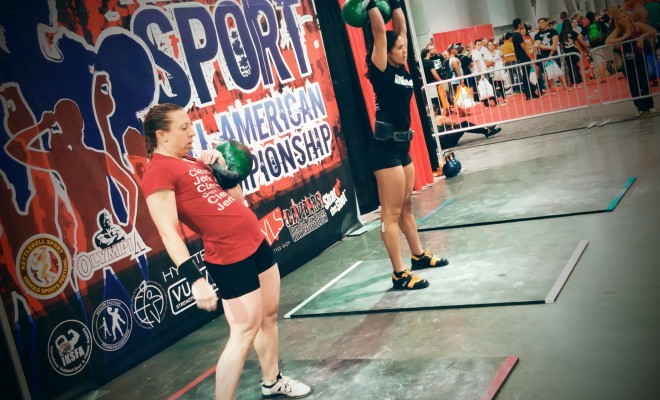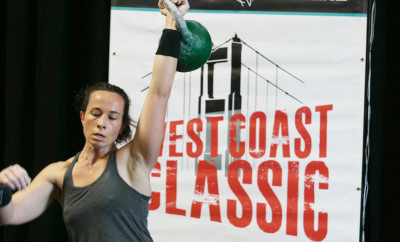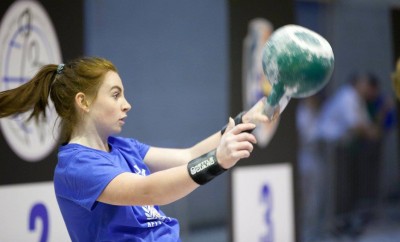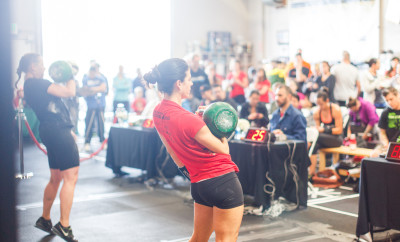
The Controversy with Women in Kettlebell Sport (no holds barred interview with Catherine Imes)
Catherine Imes is not only a founding athlete, coach, and figurehead of Kettlebell Sport in the USA, but she is also a historian and stark critic of the American culture and politics that surround it. The following transcript is from a no holds barred interview recorded live on the fly on March 29, 2016. Read at your own risk.

First of all, tell us who you are, and why people should even listen to what you have to say?
CI: Well, besides the obvious (My Name), I was the first named Master of Sports in the USA. This was when the standards were admittedly lower in terms of bell weight, but were on par with the international standards at the time. In terms of why someone should listen to me… I think that it is mainly because I’ve been in the game for a long time and seen a lot of things transpire. I’ve also done as much volunteer judging and coaching as probably still anyone to date in the USA. I didn’t enter in the sport to make money and don’t have a fitness related job.. I loved the sport and the people involved in it and paid $1000s to attend meets with only a handful of attendees. Trust me, this wasn’t for a participation medal (because in the early days you didn’t get medals at small meets lol). It was because I wanted to lift and test myself and sometimes the only “gauge” was what we thought the ranks were in the European federations. The other thing is that I’ve had some good success as a coach and I think that is partially because I didn’t pick up on the jerk easily. I worked on them for years.
Give us a general timeline for reference. What were the major milestones that gave Kettlebell Sport its popularity in the USA?
CI: 2003 was the first meet, May 2004 was the first National Championships – NAKF, November 2005 was the first USA team to Moscow, World Championships. November 2006 was the first time a USA resident medaled in a World Championship (me in Latvia), May 2007 was the resurgence of the sport with a big competition in Salt Lake City, Utah.
November 2007 was the first WKC Worlds – This included major Russian and Latvian IUKL lifters – Denisov, Kratsov, Ginko, etc.
2007 – Ushered in VF and his certs. And as you know, we all met in January, 2008 in San Diego at a sizable certification, and you all were part of a very big meet in Las Vegas at the WKC National Championships in May, 2008.
2009 was the first Arnolds, and honestly I think that may have been the biggest competition at that point in the states. 2009 definitely brought to light a divide. After the Arnolds in 2009, it was clear that there were different interpretations of standards. That was the first major controversy. The other one in 2009 was the addition of the 20kg weight – this was not well received initially, but now I think it is well understood why this was chosen.
But, I think starting in 2007 the addition of the one armed events (Jerk and Long Cycle) for women was sort of a major watershed moment. If it was just snatch only – I think the sport would have died. If we persisted with doubles after 2006 as a mandatory event, it would have died.

So help me understand this – if in fact that women doing jerk and long cycle is the actual catalyst that popularized kettlebell sport in the USA, why do you think it is that some people today believe that jerk and long cycle for women is an “inequality” issue?
So, I don’t know about inequality. I know that there are sports (and we can argue about dangers or whatever) where women don’t do the same events. You made a valid gymnastics comparison a while back. Like it or not, women are different than men. Having “boobs” can make a rack harder. Does it pose a threat like some say? I’m not sure it does and would probably say no. But, if doubles are the only option, it makes the sport inaccessible to some. The argument could be made that men with certain body types have this issue, and that would be valid. And to be clear, sports are NOT about equality. Sports can favor a specific body type and genetics at the elite level. Accessibility is required for growth and participation at general levels. I think that the introduction of the one arm events was the best way to integrate those lifts and skills. I did one arm work for a long time before re-tackling doubles and hitting 10 min with appreciable weights on doubles (16 and 20 back in 2009). So, I think the one arm work was the catalyst in terms of giving women a challenge beyond the snatch. With enhanced rankings, the heavier one arm lifts really challenged women (24kg and beyond). If 2 arm lifts are now acceptable, it was definitely because of the one arm introduction and timeline.
Wait, what? You DID two arm work back in 2009? I thought two arm work is a new invention (insert sarcasm)?
CI: Ha. Well, I did it back in 2004 – 2005. Albeit, I sucked. I was stuck at 40 reps (and I’m pretty sure fixation was iffy) and I couldn’t go 10 min in either lift. In 2007, I attended an IKFF meet in Michigan. I did Long Cycle with 2-16kg bells and I think 60 reps in 10 min.. I did it as a break from snatching for a 3 weeks. But I was well conditioned from fast paced snatching and had great grip endurance. I didn’t pick up the doubles again until 2009, but i had been working heavy 6-10 min sets with a single 24-32kg bell. My best with 2-16kg jerks (not long cycle) was 100 reps in training and 70 reps with 20s. I still have a video on Youtube of me doing a 5 min set jerk set with 2 x 24kg.
So, double bell work is not new. We were doing them in 2004-2006 in competitions. So, besides women like Jen Morey, Lorraine Patten, there were a few others. Maryanne McCarthy did doubles in Biathlon and Long Cycle if I recall correctly. Meyer Liu was doing doubles in IGSF type competitions (Dmitry Sataev was her coach). She was on the USA team that went to Moscow in 2005.
Of course, the Ice Chamber women (Surya comes to mind), Katarina and others in Europe (Finland, Norway) were doing them in training and I’m sure there may have been some in competitions.
Let’s not forget that Tatiana Potemkina has been doing them for a long time. I remember being in Latvia and Valery (Fedorenko) telling me she was competing in smaller competitions alongside men with the 24s and she was showing him her certificates. He told me that she had done 70 reps with the 2 x 24kg jerk and snatched the 24kg 140 reps in a biathlon competition. This was in 2006. I think it is a travesty that more people in this sport don’t know who she is.

So why do you think these facts aren’t recognized in the dialogues (debates) of current kettlebell sport politics?
Why do I think it isn’t recognized? Well, it’s tedious to gather details right. It’s far easier to just pretend you’re the first. It may not be recognized by men forming the organizations or making the ranks. I think the women athletes recognize those that came before them and that is what is important.
The decision we made to stop doing them was mainly because we wanted to compete internationally and the doubles didn’t serve that cause. Yeah, we could have just stayed home and lifted / competed with the doubles, and the sport most certainly would have died. It was never that we thought we couldn’t do it or shouldn’t do it. It was more about what we needed to do at the time for the sport here.
The fact is that the Russian Coaches coaching women in doubles have the avenues to do that now. However, they wouldn’t have had them or not to the extent they do now, if we hadn’t made the trips abroad to compete snatch only and “networked” over several years.

Speaking of snatch, why have we not seen more people, men or women, hit Master of Sport numbers (using Russian standards) in snatch (or biathlon) in the USA?
CI: Well, distraction/impatience? Seriously, I thought about this the other day. If you look at the controversy with the doubles, what is the event in question or the one women are training? Long Cycle. There isn’t much talk of snatch.
Snatch with a 24kg is a different animal and obviously it is with the 32kg. When I worked with doubles back in 2009, I was adept at snatch (and not great), but it seemed easier by comparison when using the same weight especially once I found a resting position. You don’t have the hand or grip issues or the localized grip failure that you do with heavier snatch. I mean that is why I admire Melissa (Swanson). She jumped in and did doubles without specific training. This shows a lot of confidence that is the result of her intense snatch training. At a lower level, I can relate. When my snatch training was going well and intense, tackling doubles or heavy singles was not a big deal.
When coaching, I had men hit 10 min sets and decent amount of reps in Jerk with 28s and 32s. Their snatch lagged. Didn’t mean they were bad at it. Their good rack helped them progress with jerks more quickly and there were discussions about switching to long cycle. I think folks get frustrated with snatch at higher weights and it requires a bit more patience and it doesn’t favor a body type. If you have just been training snatch, you get accustomed to the frustration and develop patience out of necessity.
Do you realize you could be pissing people off by saying this?
CI: I don’t care. It’s not an indictment of anyone. I have lived this. I started off doing doubles and only made 5 min sets with 2-16kg bells in 2004. At the time, I couldn’t imagine going 10 min in either lift. Long Cycle is a little forgiving because it doesn’t require the ideal rack – although it helps. I’ve got short arms and a gut (smaller than I had but still there). The snatch prepped me for the mental challenges of the sport and made doubles possible. Maybe the reverse is true for some. But I think snatch provides a great foundation and I think there is proof of that.

How do you determine who is a great kettlebell lifter? There are so many ranks available now, and their difficulty levels vary so much across many organizations.
Well, if I look at an International Level – Ksenia is the best lifter from what I can see on Youtube and the results posted. Abi Johnston is another phenomenon. Watched her lift the 28kg (one arm long cycle) the other day and she made that bell look really light. Her snatch progress is amazing.
Melissa’s ability to hit the 24kg snatch numbers and then work a flawless set of doubles with 16kgs (without training) just speak to her conditioning and technical prowess. I told Melissa that the thing that impressed me most was her consistent progress. I remember coming to the Ice Chamber in 2012 and doing a demo of 70/70 with 20kg – and Melissa just having missed her MS rank by a rep or 2. But, she steadily progressed from there. Since then, it was always obvious that she was very consistent and patient. Honestly, that is why I’m partial to Melissa and let’s not forget she isn’t super young, has children and doesn’t train people for living – this matters. She is a role model for any lifter in terms of her approach and work ethic.
Brittany is very impressive with doubles. I was very impressed by what I saw in February with all of her sets. Her technique is great. But, it goes back to what I said, I think she has the “roots” now to grow by working up to very respectable snatch numbers. Of course, Kim Fox is very impressive and an inspiration with the 24s in Long Cycle. Chelsey Marr? Shit, 31 reps with 2 x 28kg is probably a similar effort to 2 x 40kg+ for men. Her fixation and technique are very good. Svitlana, I think if she did doubles she would give any of these women a run for their money. Also, Katarina is someone that has trained non-stop and overcome some serious adversity – and listened to my spiel on fixation and quality! I haven’t hid my feelings on this. I love watching women lift across the spectrum of events. I look at the fixation/technique, the kettlebell weights, the event and then maybe the weight class.
There are a lot of factors (including age, composure) that go into my opinions and I’ve just touched on who I think is great based on recent inspiration. There are many.

So how should we discern ranks these days?
CI: Seriously, anyone who is remotely adept knows when they see greatness regardless of rank system. Ranks evolved for men based on progress over the years. Numbers today aren’t the same as they were 10 years ago. So, I think you have a couple of choices. You can go heavier to start and require less reps for high rank(24s), or you could go moderate weight and require reps comparable to men for high ranks (20s).
I do not think 24kg and 32kg are equivalent. 24kg is not too heavy, but it was chosen for snatch only.
For all of the talk about differentiation and not doing something or accepting something just because it was decided by a specific org, I am surprised there hasn’t been more critical thinking in regards to the weights and the ranks.
Have we seen 10 minute sets with 90-100 reps with 20s on Long Cycle? I’m sure Kim and Chelsey are capable. But, most of what I’ve seen in competitions are very fast paces with 16s (110+) or slower paced sets with 24s or 28s (30-60s).
Recently women have put up high jerk + snatch with the 16s (120+/200+). I think for especially Biathlon it would be prudent to keep the 20s for the higher ranks. Until we are at a place where you have multiple women breaking 100 Jerks with 20s, and 180+ snatches in the same meet, it is probably heavy enough. Even then if you make a comparison to men, you would need a heavyweight woman consistently breaking 150 and doing over 200 snatches within a few years (Denisov hit 175 Jerks 10+ Years ago and he hadn’t been training for 10 years when he did it). Women who are successful with 24kg snatch have focused on Snatch. Women who are successful with heavier weight long cycle have focused on Long Cycle. We’ll see what happens with Biathlon but it is likely to be an entirely different animal.

Give us sage advice for positive growth on a personal and national level.
CI: So, this is my advice as someone who has made mistakes and misjudgments.
1. Value your relationships with coaches, peers and competitors. You can learn from everyone whether you realize it or not. Remember tomorrow is promised to no one. So, if you piss folks off ensure there is good reason.
2. Quality – I think standards are improved, but it was browbeat into folks. Embrace the standards as a means to improve your numbers and your rank. The process is invaluable.
3. Accessibility – ensure that the sport can be performed at a moderate level, with good standards vs. just a chosen few who are either genetic freaks or who just have an unusual will to thrive. Sports like Marathons are accessible to many and I think this sport can be as well.







1 Comment